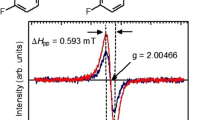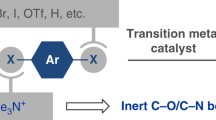Summary
The oxidation reaction of dithia[3.3]metacyclophane-containing π-conjugated polymer (3) was performed by the treatment with m-chloroperbenzoic acid (m-CPBA). The reaction proceeded smoothly to obtain the corresponding oxidized polymer (4), and all sulfur atoms of the dithia[3.3]metacyclophane unit were converted to the sulfone group according to the 1H, 13C NMR, and IR spectra. The rapid syn-[anti]-syn interconversion of the oxidized dithia[3.3]metacyclophane moieties in polymer (4) and dithia[3.3]metacyclophane moieties in polymer (3) occured in solution at room temperature. Polymer (4) exhibited a blue emission in the same region as polymer (3).
Similar content being viewed by others
References
Skotheim TA, Elsenbaumer RL, Reynolds JR, Eds. (1998) Handbook of Conducting Polymers, 2nd ed. Marcel Dekker, New York
(a) Shirakawa H (2001) Angew Chem Int Ed 40:2574 (b) MacDiarmid AG (2001) Angew Chem Int Ed 40:2581. (c) Heeger AJ (2001) Angew Chem Int Ed 40:2591
(a) Kraft A, Grimsdale AC, Holmes AB (1998) Angew Chem Int Ed 37:402 (b) Friend RH, Gymer RW, Holmes AB, Burroughes JH, Marks RN, Taliani C, Bradley DDC, Dos Santos DA, Bredas JL, Lögdlund M, Salaneck WR (1999) Nature 397:121 (c) Mitschke U, Bauerle P (2000) J Mater Chem 10:1471. (d) Bernius MT, Inbasekaran M, O’Brien J, Wu W (2000) Adv Mater 121:1737 (e) Akcelrud L (2003) Prog Polym Sci 28:875
(a) Nehring J, Amstutz H, Holmes PA, Nevin A (1987) Appl Phys Lett 51:1283 (b) Moll A, Siegfried N, Heitz W (1990) Makromol Chem Rapid Commun 11:485 (c) Witteler H, Lieser G, Wegner G, Schulze M (1993) Makromol Chem Rapid Commun 14:471
(a) Messir J, Kajzar F, Prasad PN, Ulrich DR, Eds. (1989) Nonlinear Optical Effects in Organic Polymers (NATO ASI Series E: Applied Sciences vol. 162). Kluwer Academic Publishers, Dordrecht (b) Pasad PN, Williams DJ (1991) Introduction to Nonlinear Optical Effects in Molecules and Polymers. Wiley-Interscience, New York (c) Bredas JL, Adant C, Tackx P, Persoons A, Pierce BM (1994) Chem Rev 94:243
(a) Vögtle F (1993) Cyclophane Chemistry. Wiley&Sons, New York (b) Shultz J, Vögtle F (1994) Top Curr Chem 172:42 (c) Cleiter R, Hopf H, Eds. (2004) Modern Cyclophane Chemistry. Wiley-VCH, Weinheim
(a) Morisaki Y, Chujo Y (2002) Macromolecules 35:587 (b) Morisaki Y, Chujo Y (2002) Chem Lett 194 (c) Morisaki Y, Ishida T, Chujo Y (2002) Macromolecules 35:7872 (d) Morisaki Y, Chujo Y (2002) Polym Bull 49:209 (e) Morisaki Y, Fujimura F, Chujo Y (2003) Organometallics 22:3553 (f) Morisaki Y, Chujo Y (2003) Macromolecules 36:9319 (g) Morisaki Y, Chujo Y (2004) Macromolecules 37:4099 (h) Morisaki Y, Ishida T, Tanaka H, Chujo Y (2004) J Polym Sci Part A Polym Chem 42:5891 (i) Morisaki Y, Wada N, Chujo Y (2005) Polym Bull 53:73 (j) Morisaki Y, Wada N, Chujo Y (2005) Polymer 46:5884 (k) Morisaki Y, Chujo Y (2005) Bull Chem Soc Jpn 78:288
Mizogami S, Yoshimura S (1985) J Chem Soc Chem Commun 1736
(a) Morisaki Y, Ishida T, Chujo Y (2003) Polym J 35:501 (b) Morisaki Y, Ishida T, Chujo Y (2006) Org Lett 8:1029
Givens RS, Olsen RJ (1979) J Org Chem 44:1608
(a) Li H, Powell DR, Hayashi RK, West R (1998) Macromolecules 31:52 (b) Moroni M, Le Moigne J (1994) Macromolecules 27:562
Sonogashira K, Tohda Y, Hagihara N (1975) Tetrahedron Lett 16:4467
Otsubo T, Kitasawa M, Misumi S (1979) Bull Chem Soc Jpn 52:1515
Sato T, Wakabayashi M, Hata K, Kainosho M (1971) Tetrahedron 27:2737
The absorbance (a.u.) of each sample was below 0.05 at the excitation wavelength in the measurement of the fluorescence quantum yield. The quantum yield (Φunk) of unknown sample was calculated by the following equation: Φunk=Φstd[AstdFunk/AunkFstd][nD,unk/nD,std]2 where Astd and Aunk are the absorbance of the standard and unknown sample, respectively, Fstd and Funk are the corresponding relative integrated fluorescence intensities, and nD is the refractive index [CH2Cl2 (nD = 1.424) and CHCl3 (nD = 1.446) were used.]
(a) Oldham Jr WJ, Miao YJ, Lachicotte RJ, Bazan GC (1998) J Am Chem Soc 120:419 (b) Bazan GC, Oldham Jr WJ, Lachicotte RJ, Tretiak S, Chernyak V, Mukamel S (1998) J Am Chem Soc 120:9188 (c) Wang S, Bazan GC, Tretiak S, Mukamel S (2000) J Am Chem Soc 122:1289
Author information
Authors and Affiliations
Corresponding author
Rights and permissions
About this article
Cite this article
Morisaki, Y., Ishida, T. & Chujo, Y. Oxidation of Dithia[3.3]metacyclophane-Containing Through-Space π-Conjugated Polymer. Polym. Bull. 57, 623–630 (2006). https://doi.org/10.1007/s00289-006-0622-3
Received:
Revised:
Accepted:
Published:
Issue Date:
DOI: https://doi.org/10.1007/s00289-006-0622-3




